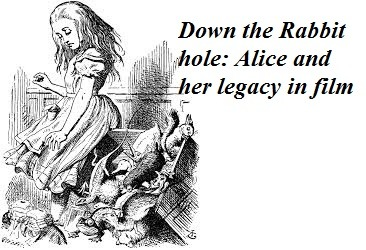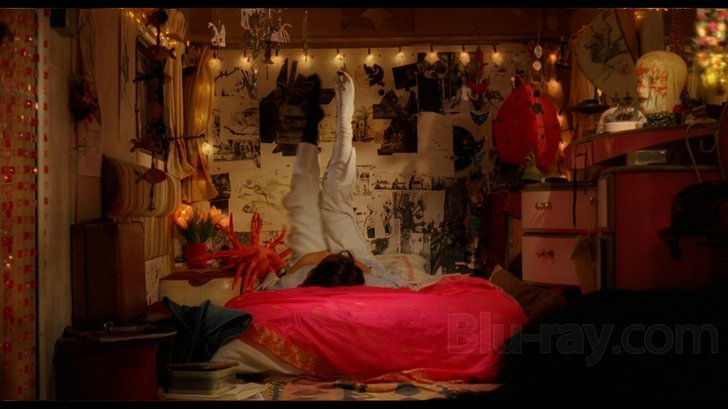
NOTE JANUARY 2025: NEIL GAIMAN IS AN ABUSER, I WROTE THIS PIECE FAR BEFORE ANYONE KNEW. PLEASE READ THE SIDE OF NEIL GAIMAN HIS FANS NEVER SAW, BY LAUREN STARKE (TRIGGER WARNINGS APPLY)
NEXT WEEK: Labyrinth (1986)
PLEASE NOTE: This is more of a comparison/review than an essay. I couldn't write an essay for this as it is too simplistic.
Helena, a keen teenage artist, works with her parents in the circus, but yearns for a life more ordinary. After a particularly vicious fight, Helena becomes wrecked with guilt when her mother is hospitalized with her life hanging in the balance. Helena soon descends into a fantasy world where the balance of light and dark has been tipped, and the light White Queen cannot awaken unless Helena finds a powerful charm...

Much like Girl Asleep, I wanted with all my heart to love Mirrormask. For one, its creative credentials are stellar. The script is by the author of Coraline, Neil Gaiman, with directorial duties by Gaiman's illustrator Dave Mackean. I adore the work of both of these creatives.
So why did Mirrormask just leave me cold?
The main problem is the story. Despite some neat ideas (which I'll go into later) similar to last week's film Girl Asleep, the story is too busy and overzealous with explaining itself to really feel imaginative.
PLEASE NOTE: This is more of a comparison/review than an essay. I couldn't write an essay for this as it is too simplistic.
Helena, a keen teenage artist, works with her parents in the circus, but yearns for a life more ordinary. After a particularly vicious fight, Helena becomes wrecked with guilt when her mother is hospitalized with her life hanging in the balance. Helena soon descends into a fantasy world where the balance of light and dark has been tipped, and the light White Queen cannot awaken unless Helena finds a powerful charm...

Much like Girl Asleep, I wanted with all my heart to love Mirrormask. For one, its creative credentials are stellar. The script is by the author of Coraline, Neil Gaiman, with directorial duties by Gaiman's illustrator Dave Mackean. I adore the work of both of these creatives.
So why did Mirrormask just leave me cold?
The main problem is the story. Despite some neat ideas (which I'll go into later) similar to last week's film Girl Asleep, the story is too busy and overzealous with explaining itself to really feel imaginative.
We know that the White and Dark Queens are both representing Helena's mother. And that the Prime Minister represents her father and Anti Helena is the negative side of herself.








These obvious symbols are extremely distracting as we always know the whys and hows of everything.
For example, the oddities and citizens like the faceless librarian or stretched face sphinxes can be attributed to the fact the fantasy world is based on Helena's drawings.
Part of the charm of Carroll's Alice novels are that nothing is ever explained. In Mirrormask however, nearly everything is, sucking out most of the wonders in the process. Despite being set in a dream world, Mirrormask mostly lacks the dreamlike surrealism of Carroll.
That being said, there are a good few redeeming features. Some of the main set pieces (the library scene, the mechanical dolls scene, the Gryphon) are left unexplained and therefore work wonderfully. Dave Mackean's art is beautiful and gothic, shining through despite some extremely bad CGI in occasional parts.
But by far the best concept this film offers is in how it references and inverts Carroll's Alice.
FOLLOWING CHARACTERS
it flashed across her mind that she had never before see a rabbit with either a waistcoat-pocket, or a watch to take out of it, and burning with curiosity, she ran across the field after it.
Helena is spirited away into her fantasy world after following several strange looking musicians that appear in her flat. They are extremely confused when she mistakes them for people she knows. One turns into stone, and Helena realises she is no longer in reality.
This sequence is an obvious parallel to Alice following the White Rabbit into Wonderland, except here music is involved and the transition is more subtle. It is only when the library wall appears that the audience and Helena are aware that reality has disappeared.
If I had any complaint, it is that this transition does not feel as momentous as it should, and feels slightly too long.
RIDDLES WITH NO ANSWERS AND GRINNING CATS (ISH)
Have you guessed the riddle yet?’ the Hatter said, turning to Alice again. `No, I give it up,’ Alice replied: `that’s the answer?’ `I haven’t the slightest idea,’ said the Hatter.
The Gryphon creature (not at all like Carroll's!) that Helena comes across early in her adventures is obsessed with riddles, to the point that he will not let her pass into the land of giants.
What follows is a delightful Carroll esque exchange of riddles with deliberately no answer which are designed to infuriate Helena. It's not hard to make comparisons with Carroll's Hatter.
Unlike Alice, Helena tricks her riddle asker by giving him something she knows he'll never solve, a riddle her father once told her. The Gryphon is so wrapped up by solving she is allowed to pass.

Later on Helena meets strange cat like Sphinxes which eat books, and grin like Cheshire cats. However they are much more malicious and at one point attempt to hurt her and her companion.

POEMS AND STORIES
The Walrus and the Carpenter, Were walking close at hand; They wept like anything to see
Such quantities of sand: "If this were only cleared away," They said, "it would be grand!"
Much like Carroll, stories within stories feature heavily in Mirrormask. Whilst in Wonderland and Looking Glass World Alice has to recite and hear poems, Helena is told the story of the light and dark lands from the Prime Minister, and the story of the 2 Helena's from the faceless librarian.
Both of these stories, unlike in Carroll's, allow the protagonist to understand more of the world they have been trapped in. The poems that Alice hears and recites only serve to heighten her confusion.
LOOKING GLASS HOUSE
"Oh, what fun it'll be, when they see me through the glass in here, and can't get at me!'
Ironically Helena has the exact opposite reaction to Carroll's Alice in Through the Looking Glass. Whilst Alice is glad to finally visit a mirror world, Helena is trapped in one and is horrified at the idea of seeing her flat but not being able to get back. This fear worsens when she realises that there is another version of herself.

PRETENDING TO BE 2 PEOPLE
This curious child was very fond of pretending to be two people. `But it’s no use now,’ thought poor Alice, `to pretend to be two people! Why, there’s hardly enough of me left to make ONE respectable person!’
Carroll's Alice never splits into two versions of herself, even if at one point in Wonderland she tries to pretend she is two people. But Helena untentionally has.
Perhaps the most interesting idea that Mirrormask has and its most interesting inversion on Carroll is that to leave her fantasy world, Helena must not defeat an evil power, but learn to reconcile another part of herself which is running amok in the real world. This is a powerful idea and not something I've ever seen in a film of this genre before.
CONCLUSION
Overall Mirrormask is an interesting but ultimately very flawed experiment. Ideas that work do work, but the ones that don't drag the film down. It's definitely one of those watch once films.
NOTES:
• Made into a graphic novel by Neil Gaiman after filming.
• Both Coraline and Mirrormask feature evil mother figures in other realms which the heroine must escape. Mirrormask is less subtle.
• In a nice reference to Coraline, the tale of the two kingdoms is told by performing mice.
• "Wake the White Queen" is a song by the Cruxshadows which is about this film.
• This brilliant scene with mechanical dolls is the best in the film by far.